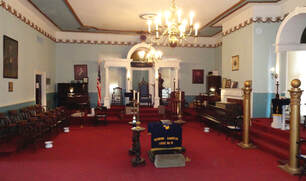Tips on Learning Ritual from my Perspective

The difference between a Ritual and a Ceremony is that a Ritual uses the same words and movements each time. This connects you to brothers who were raised generations ago and brothers from other lodges you have never met. You have a link to all of them through time and place. All these brothers have been initiated using the same Ritual. Rituals are especially important to lodges. These include openings, closings, lectures, and so forth used in meetings and degrees, Ceremonies are also important. A church service would be a ceremony because different songs and sermons are used each week. A funeral service would also be considered a ceremony.
Never assume you will learn lectures in a few mega sessions. Usually, it is not good to spend more than an hour in any one day studying a lecture. It just takes time to first get to know the flow of a lecture and then to start concentrating on various sections. Relax, let your mind tell you how it wants to learn.
Reading aloud greatly helps because it gets the two sides of the mind working together. When you are giving a lecture, you can sometimes feel the other side of your mind double check what is flowing out of your mouth. You become very aware that your brain has crosschecks.
If you have ever taken a karate class you learn that when you practice movements, you let your mind relax. Your various limbs will remember the movements without your thinking about them. The lectures are similar. You are using parts of the mind you do not normally use. You just let the lecture flow out of this section of the mind without consciously thinking about it. Obviously, this means it takes time to learn lectures. We use similar sections in our mind to learn poems and songs. While giving lectures, your consciousness should be focused on the responses of your candidate, the responses of the audience, and the use of a chart or slideshow.
One of the first things to remember is not to try to learn lectures one word at a time. When you read the lectures for each of the three degrees, each lecture has three major themes. Understand various images and stories that lectures create and then learn the words around these images and stories presented.
One important observation I have made is the lectures are usually easiest the first time you give them in an open lodge because you are very well prepared. The second and third time you might have more difficulty because of over confidence. Always review a lecture before giving it. Watching others give a lecture you know can also reinforce your knowledge of it and help you to correct a few wrong words you may have substituted here and there. After you have given a lecture several times, you begin to really learn the lecture and the meanings behind it that are not at first apparent. This benefits you as well. Practice! Practice! Practice!
Never assume you will learn lectures in a few mega sessions. Usually, it is not good to spend more than an hour in any one day studying a lecture. It just takes time to first get to know the flow of a lecture and then to start concentrating on various sections. Relax, let your mind tell you how it wants to learn.
Reading aloud greatly helps because it gets the two sides of the mind working together. When you are giving a lecture, you can sometimes feel the other side of your mind double check what is flowing out of your mouth. You become very aware that your brain has crosschecks.
If you have ever taken a karate class you learn that when you practice movements, you let your mind relax. Your various limbs will remember the movements without your thinking about them. The lectures are similar. You are using parts of the mind you do not normally use. You just let the lecture flow out of this section of the mind without consciously thinking about it. Obviously, this means it takes time to learn lectures. We use similar sections in our mind to learn poems and songs. While giving lectures, your consciousness should be focused on the responses of your candidate, the responses of the audience, and the use of a chart or slideshow.
One of the first things to remember is not to try to learn lectures one word at a time. When you read the lectures for each of the three degrees, each lecture has three major themes. Understand various images and stories that lectures create and then learn the words around these images and stories presented.
One important observation I have made is the lectures are usually easiest the first time you give them in an open lodge because you are very well prepared. The second and third time you might have more difficulty because of over confidence. Always review a lecture before giving it. Watching others give a lecture you know can also reinforce your knowledge of it and help you to correct a few wrong words you may have substituted here and there. After you have given a lecture several times, you begin to really learn the lecture and the meanings behind it that are not at first apparent. This benefits you as well. Practice! Practice! Practice!